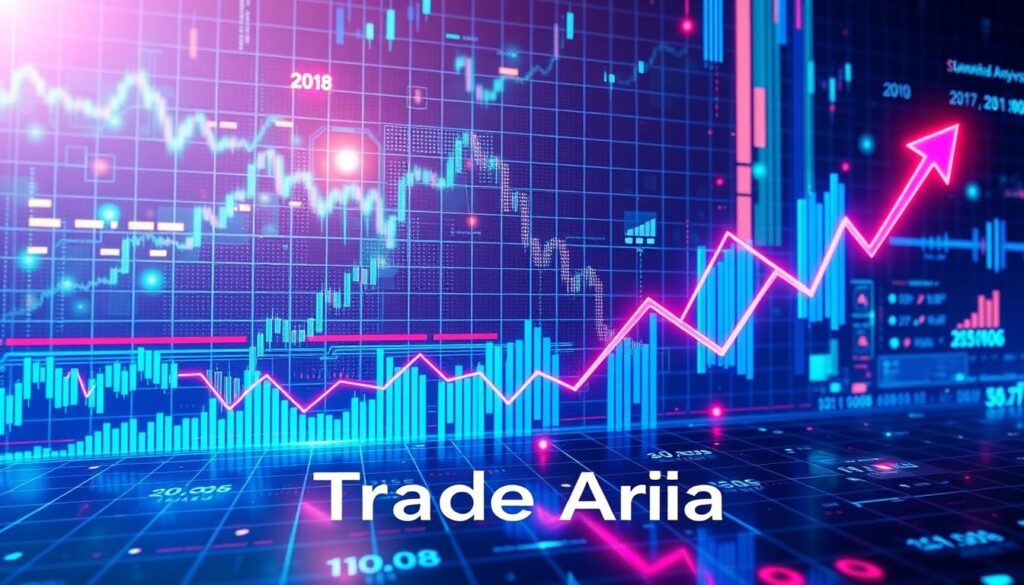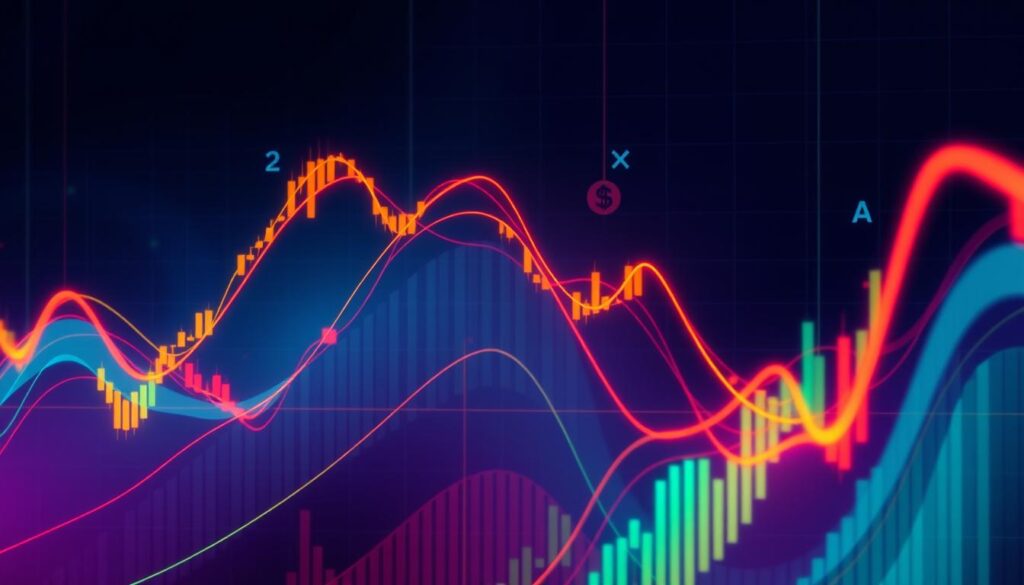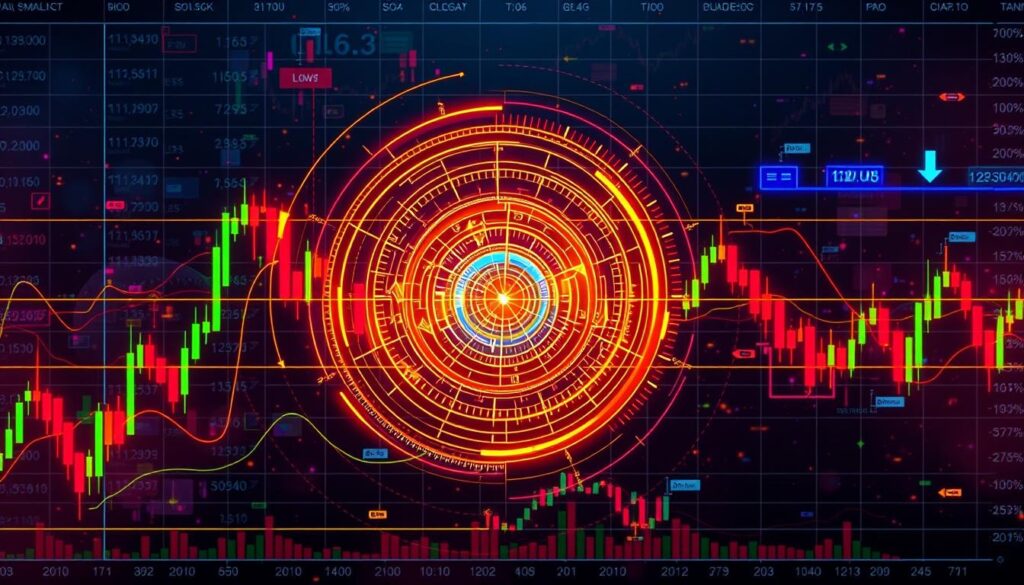Technical analysis is a key tool for understanding the stock market. It looks at price movements, trading volumes, and indicators. Analysts use this to predict future prices and spot trends. This guide will teach you the basics and techniques of stock market technical analysis. It will help you make better trading choices.
Key Takeaways
- Technical analysis studies market data like price, volume, and indicators to find patterns and trends.
- Traders and investors use it to decide when to buy, sell, or manage their stock market positions.
- Technical analysis can be done on charts from 5 minutes to daily or weekly, based on the trader’s style and goals.
- It uses tools like candlestick patterns, moving averages, and momentum indicators to analyze the market.
- Learning technical analysis can help traders create effective strategies and manage risks better.
Understanding Technical Analysis Fundamentals
Technical analysis is a key tool for traders and investors. It looks at past price actions and market data to spot trends. This helps make better trading choices. It’s different from fundamental analysis, which looks at a company’s finances and the economy.
The Psychology Behind Market Movements
Technical analysis believes market psychology is key to price changes. It studies how people feel and act in the market. This helps traders understand what drives stock prices.
Feelings like fear and greed show up in buying and selling. These patterns are what technical analysts look for to make money.
Key Components of Technical Analysis
- Price Action: The heart of technical analysis is watching price changes over time. Traders look at chart patterns and trend indicators to understand the market.
- Trading Volume: The number of shares traded gives clues about market strength. Analysts use volume to check if price trends are real and to find turning points.
- Technical Indicators: Many tools, like moving averages and oscillators, help spot trends and buy/sell signals. They show when the market might be overbought or oversold.
Price Action and Market Data
Technical analysis is all about price action and market data. By studying charts, traders find support and resistance levels. They also look for trend lines and patterns that hint at future prices.
Looking at trading volume helps understand the market’s strength. It shows if trends are strong or weak.
“The market is a complex system, driven by the collective behavior of market participants. Technical analysis allows us to tap into this collective psychology and make informed trading decisions based on the observable patterns in price and volume.”
Getting Started with Chart Analysis
Successful traders know the power of chart analysis in the stock market. They study price patterns, technical indicators, and trend lines. This helps them make smart trading decisions. Whether you’re new or experienced, learning chart analysis is key to making money.
When starting with chart analysis, pick a time frame. Traders use different time frames like 5-minute, 15-minute, and daily charts. The time frame you choose affects how you see market trends and signals.
Chart analysis is about spotting chart patterns, using technical indicators, and finding support and resistance levels. Knowing these concepts helps you spot trading chances and make smart choices.
- Look for common chart patterns: Patterns like head and shoulders and triangles show market direction.
- Use technical indicators: Tools like moving averages and RSI help analyze trends and find buy or sell signals.
- Understand support and resistance levels: These levels influence market behavior and offer trade entry and exit points.
Chart analysis takes practice and learning. By using these methods, you’ll get better at understanding the market. This will improve your trading skills.
“The key to successful chart analysis is to identify clear patterns, trends, and technical indicators that align with your trading strategy.”
Start your chart analysis journey with patience and discipline. Always remember to manage risks. With the right approach and knowledge, you’ll make better trading choices and reach your financial goals.
Essential Price Chart Types
In the world of technical analysis, knowing different price chart types is key. Traders use them to analyze market movements and find trading chances. The main types are candlestick charts, bar charts, and line charts.
Candlestick Charts
Candlestick charts are the top choice for showing price action. Each candlestick shows a time period’s opening, closing, high, and low prices. The body of the candlestick shows the price range, and the wicks show the highs and lows.
Candlestick patterns, like bullish and bearish engulfing patterns, offer insights into market mood and future price moves.
Bar Charts
Bar charts show the same info as candlestick charts but differently. Each bar represents a time period and shows the opening, closing, high, and low prices. They help spot trends and support/resistance levels, and analyze bar chart patterns.
Line Charts
Line charts focus on closing prices to show market trends. They don’t show highs, lows, or opening prices. Instead, they connect closing prices over time, showing overall price movement.
They’re great for long-term trend analysis and spotting key support and resistance levels.
Knowing these chart types is vital for good technical analysis. It helps traders spot important price patterns for their trading decisions.
“The most successful traders are those who have a deep understanding of the different chart types and the information they convey.”
Stock Market Technical Analysis: Core Principles
For traders in the stock market, knowing the basics of technical analysis is key. This method looks at past prices, trends, and psychology to guess future prices. It’s built on three main ideas: spotting trends, finding support and resistance, and studying market structure.
Spotting price trends is vital. By looking at past prices, traders can see if the market is going up, down, or staying the same. Knowing these trends helps traders decide when to buy or sell, using the market’s momentum to their advantage.
Support and resistance levels are also crucial. These are prices where the market often changes direction. Finding these levels helps traders guess when the market might turn around and plan their moves.
- Support levels are prices where demand stops a fall and might turn it around.
- Resistance levels are prices where supply stops a rise and might turn it around.
Lastly, analyzing market structure is important. This means looking at the market’s overall shape and patterns, like consolidation zones and trend lines. Understanding these helps traders find good trading chances and manage risks better.
“The key to successful trading is to focus on the market’s structure, not just the current price.” – Mark Douglas, author of “The Disciplined Trader”
These basic principles are the base for more complex techniques, like candlestick patterns and moving averages. By getting these basics right, traders can improve their market understanding and make better investment choices.
Understanding Support and Resistance Levels
In the world of technical analysis, support and resistance levels are key. Support levels are where prices tend to pause or reverse downward. Resistance levels are where prices often stall or reverse upward. Knowing these levels helps traders predict price changes.
Identifying Key Price Levels
Traders use charts and tools like trendlines and moving averages to find these levels. These levels are shaped by market psychology and past experiences. Support levels show where buyers step in, reversing price drops. Resistance levels show where selling outpaces buying, potentially reversing price.
Breakout and Breakdown Points
When price crosses support or resistance, it signals a breakout or breakdown. This indicates a new trend. Traders watch these points closely for insights into future market moves. Breakouts can lead to big price changes as traders and investors jump into the new trend.
Trading Range Analysis
Trading range analysis looks at price movements between support and resistance. It helps find trading opportunities. By knowing a trading range’s boundaries, traders can plan their moves. This is especially useful in volatile markets where prices stay within a range.
“Support and resistance levels are like the guardrails on a highway, guiding the price action and providing valuable insights into market psychology.”
Understanding support and resistance levels is vital in technical analysis. It helps traders and investors predict price changes, breakouts, and trading opportunities in the stock market.
Moving Averages and Trend Analysis
Traders and investors often use moving averages for analysis. These tools smooth out price data, showing trends and support or resistance levels. The simple moving average (SMA) and the exponential moving average (EMA) are two main types.
The simple moving average averages prices over a set number of periods, giving each point equal weight. The exponential moving average focuses more on recent prices, making it quicker to react to market changes.
Investors watch the 50-day and 200-day moving averages closely. These are key signals in stock market analysis. Short-term traders might use the 20-day EMA, while long-term investors prefer the 200-day SMA.
Moving average crossovers signal trend changes. For example, when the 50-day SMA goes above the 200-day SMA, it might mean a bullish breakout.
Traders use moving averages to spot trends, get trading signals, and find support and resistance. But, these tools can lag behind fast price changes and give false signals in volatile markets.
Knowing how simple and exponential moving averages work is crucial. It helps traders and investors understand trends and make better decisions in the financial markets.
Essential Candlestick Patterns
Technical analysis often uses candlestick patterns to understand stock market data. These patterns show price movements and can hint at market changes. Knowing how to read doji candlesticks, bullish engulfing, bearish engulfing, and harami patterns can help traders make better choices.
Bullish Patterns
Bullish patterns, like the hammer or bullish engulfing, hint at price going up. The hammer has a small body with a long lower shadow, showing buyers pushed prices up after selling. The bullish engulfing pattern, with a big green candle covering a red one, signals a shift in market mood.
Bearish Patterns
Bearish patterns, like the shooting star or bearish engulfing, suggest prices might fall. The shooting star has a small lower body and a long upper shadow, showing selling pressure. The bearish engulfing pattern, with a big red candle covering a green one, means sellers are winning.
Continuation Patterns
There are also continuation patterns that show a trend is likely to keep going. The harami pattern is a two-candle setup where a small candle fits inside the body of a larger one. It means the trend is probably going to keep going.
Understanding these candlestick patterns can improve market analysis and trading decisions. Using these visual clues in technical analysis can give traders an edge in the stock market.
“Candlestick charts are a powerful tool for traders, as they can provide insight into market sentiment and potential price movements. By mastering the interpretation of these patterns, traders can gain a significant advantage in their trading strategies.”
Volume Analysis and Trading Indicators
In stock trading, trading volume is key. It shows how many shares or contracts are traded in a time. This gives clues about the strength of market moves.
When volume is high, big price changes often happen. This means many people are interested and sure about the market. But, low volume might mean not many people are sure about the trend. Volume indicators, like On-Balance Volume (OBV), help see how price and volume relate. They show when trends might change or keep going.
OBV tracks money flow into and out of a stock. It shows who is buying and selling. If prices go up with more volume, OBV goes up too. This means people are buying a lot. But, if prices fall with more volume, OBV falls. This shows people are selling a lot.
“Volume is the lifeblood of the market. It confirms the strength of trends and can provide early warning signs of potential reversals.”
Other indicators, like Chaikin Money Flow and Volume Price Trend, also help understand the market. They are part of a trader’s tools. Using volume analysis helps investors understand market feelings better. This leads to smarter choices.
In short, volume analysis and volume indicators are vital in technical analysis. They help traders see if price moves are strong or weak. They also help spot when trends might change. By knowing how price and volume work together, traders can make better choices.
Relative Strength Index (RSI) and Momentum
The Relative Strength Index (RSI) is a key tool in technical analysis. It helps traders spot when markets are overbought or oversold. It also shows when trends might change.
Overbought and Oversold Conditions
The RSI moves between 0 and 100. Values over 70 are seen as overbought, and below 30 as oversold. These signs can hint at price drops or changes in trend. Yet, the RSI might stay in these zones for a while, especially in strong trends.
RSI Divergence Signals
Divergence is a crucial RSI signal. It happens when the RSI and price move in opposite ways. A bullish divergence shows a possible upturn. A bearish divergence might signal a downturn.
Knowing how to use the RSI indicator and momentum trading helps traders. They can make better choices about when to enter or exit the market. This can improve their success in volatile markets.
“The RSI is a powerful tool in a trader’s arsenal, providing valuable insights into market momentum and potential reversals. By mastering its interpretation, traders can gain a significant edge in navigating the complexities of the markets.”
Fibonacci Retracement Techniques
In the world of technical analysis, Fibonacci retracement has become a key tool for traders. It’s based on the work of Italian mathematician Leonardo Fibonacci. This method helps spot support and resistance levels in market price changes.
The Fibonacci sequence is a series of numbers where each number is the sum of the two before it (0, 1, 1, 2, 3, 5, 8, 13, 21, and so on). It’s found in nature, art, and market behavior. Traders use it to find key levels like 23.6%, 38.2%, 50%, 61.8%, and 78.6% in market movements.
These levels are used to analyze price retracements, or pullbacks from a trend. By spotting these levels, traders can find support or resistance points. This helps in making better trading decisions. Fibonacci analysis is great for setting entry and exit points, stop-loss levels, and price targets.
It’s crucial to remember that Fibonacci levels alone are not enough. Traders should combine them with other tools and indicators for a full strategy. The goal is to find support and resistance levels, but decisions should be based on a full market understanding.
“The Fibonacci sequence and its ratios are found in nature and human endeavors, including finance. Using Fibonacci retracement analysis can give valuable clues on price movements.”
Understanding and using Fibonacci retracement techniques can improve traders’ skills. It helps them better navigate Fibonacci levels, retracement analysis, and the golden ratio in markets. This knowledge is a strong tool for making strategic trading decisions.
Elliott Wave Theory Applications
Ralph Nelson Elliott introduced the Elliott Wave principle in the 1930s. It says financial markets follow repeating wave patterns. Uptrends have five waves, and downtrends have three.
By knowing these patterns, traders can guess where prices might go. This helps them make better trading choices.
Wave Patterns and Market Cycles
The Elliott Wave principle talks about waves in financial markets. These waves come from how investors think. Impulse waves show the main trend, and corrective waves are temporary pulls back.
The theory breaks down waves into nine degrees. This lets traders look at market movements in different ways. Corrective waves often go back in Fibonacci numbers, like 38%, 50%, and 62%. This gives clues about where prices might stop or start.
Trading with Wave Counts
Using the Elliott Wave theory is complex. But, by spotting wave patterns and tracking counts, traders can guess future price moves. This knowledge helps them make smarter trades, manage risks, and find good opportunities.
“The Elliott Wave Principle is about studying human psychology regarding buying and selling stocks. It’s not about simplifying the market, but rather about understanding its complex nature.” – A.J. Frost, co-author of “Elliott Wave Principle”
The Elliott Wave theory needs a lot of knowledge and a careful analysis approach. But, it’s a great tool for traders wanting to understand Elliott Wave principle, market cycles, and wave analysis in financial markets.
Chart Patterns and Market Structure
Chart patterns are key in technical analysis. They show the market’s psychology and future price moves. Patterns like the head and shoulders, double top, double bottom, and triangles can signal trend changes.
Chart pattern analysis helps traders find support and resistance levels. It also shows breakout points and market sentiment. By spotting these patterns, traders can guess market moves and make smarter choices.
- The head and shoulders pattern suggests a bullish-to-bearish reversal, with the “head” representing the highest point and the “shoulders” on either side being lower.
- Double top and double bottom patterns highlight trend reversals, indicating a change in market sentiment.
- Triangle patterns, such as ascending, descending, and symmetrical triangles, can signal continuation or reversal patterns depending on the market conditions.
Studies have shown these patterns’ success in predicting market moves. A 2008 study by Thomas Bulkowski found double top patterns had a 73% success rate. A 2022 study by Smith found double bottom patterns had a 70% success rate in predicting bullish reversals. Also, Anderson’s 2023 research showed ascending triangle patterns have a 75% success rate in predicting uptrends.
“Understanding chart patterns is like cracking the code of the market’s psychology. By recognizing these visual cues, traders can gain a significant edge in anticipating future price movements.”
Using chart pattern analysis in trading strategies can improve traders’ skills. Whether it’s a head and shoulders, double top, or triangle pattern, knowing these tools is crucial. It helps traders navigate the markets better and make informed decisions.
Technical Indicators for Day Trading
Day traders use technical indicators to make quick decisions. The Moving Average Convergence Divergence (MACD), Stochastic Oscillator, and Bollinger Bands are popular. These tools help understand market trends and potential price changes.
MACD Indicator
The MACD shows the market’s trend direction and strength. It uses two moving averages to generate signals. Traders look at these signals to understand trend changes.
Stochastic Oscillator
The Stochastic Oscillator measures the current close against the high-low range. It spots overbought and oversold conditions. This helps traders see when the market might reverse or consolidate.
Bollinger Bands
Bollinger Bands measure market volatility. They have a middle band and upper and lower bands. Traders use them to find support and resistance levels and spot breakouts.
Using MACD, Stochastic Oscillator, and Bollinger Bands together helps traders. They get insights into market trends and volatility. This helps them make better decisions in fast markets.
Risk Management in Technical Trading
Effective risk management is key to successful technical trading. Traders use many strategies to control risks. One main tool is stop-loss orders, which limit losses on a trade.
Position sizing is also crucial. It helps traders decide how much capital to use for each trade. This keeps risk levels in check. The risk-reward ratio helps traders see if a trade is worth it, balancing risks and rewards.
- Implement stop-loss orders to limit potential losses
- Utilize position sizing techniques to manage risk exposure
- Analyze the risk-reward ratio to identify profitable trading opportunities
Good risk management keeps capital safe and boosts long-term profits. By using these strategies, technical traders can trade with more confidence. This increases their chances of success.
“Successful trading is all about risk management. If you manage your risks, you manage your wins and losses.”
Risk management is a continuous process. It needs constant monitoring and adjustments. By being proactive, technical traders can grow sustainably in the markets.
Common Technical Analysis Mistakes to Avoid
Technical analysis is a strong tool for traders, but it has its pitfalls. One big mistake is overtrading. This happens when traders rely too much on small signals and make too many trades. This can cause big losses and hurt their profits.
Another error is confirmation bias. This is when traders only look for information that supports their views and ignore the rest. It can lead to a wrong view of the market and bad decisions. Traders should keep an open mind, question their beliefs, and seek different views.
Lastly, some traders ignore fundamental analysis and only look at technical indicators. While technical analysis is important, it’s also key to understand the economic and industry factors that affect stock prices. A mix of both is needed for smart trading decisions.
FAQ
What is technical analysis and how does it work?
Technical analysis predicts future prices by looking at past market data. It believes that all important information is reflected in market actions. Traders use price charts to guess future market moves, looking at different time frames.
What are the core principles of technical analysis?
Key principles include finding trends, support and resistance levels, and understanding market structure. These help traders decide when to buy or sell.
How are support and resistance levels used in technical analysis?
Support levels are where prices might pause or turn up. Resistance levels are where prices might pause or turn down. Knowing these helps traders predict price changes.
What are the different types of price charts used in technical analysis?
Main charts are candlestick, bar, and line charts. Each shows different things about price movements and market behavior.
How can moving averages be used to identify market trends?
Moving averages smooth out price data to show trends and levels of support or resistance. Traders watch for crossovers to signal trend changes, like buying when a short-term average goes above a long-term one.
What are some common candlestick patterns used in technical analysis?
Patterns like the hammer and bullish engulfing show potential reversals or continuations. Doji candlesticks often signal indecision and possible reversals.
How can volume analysis be used to confirm price movements?
Volume analysis confirms price movements and trend strength. High volume with a price move shows strong conviction. Tools like On-Balance Volume (OBV) help spot trend reversals or continuations.
What is the Relative Strength Index (RSI) and how is it used in technical analysis?
The Relative Strength Index (RSI) shows overbought or oversold conditions. Values over 70 are overbought, and values under 30 are oversold. Traders use these to predict price reversals.
How can Fibonacci retracement levels be applied in technical analysis?
Fibonacci retracement uses Fibonacci’s sequence to find support and resistance levels during price retracements. Traders use levels like 23.6% and 61.8% to spot these levels.
What is Elliott Wave Theory and how can it be used in trading?
Elliott Wave Theory says market movements follow patterns of waves. Uptrends have five waves, and downtrends have three. Traders use this to find turning points and predict trends.
What are some common chart patterns used in technical analysis?
Patterns include head and shoulders, double tops and bottoms, and triangles. They signal potential reversals or continuations and help find key levels.
How can technical indicators be used for day trading strategies?
Day traders use indicators like MACD and Stochastic Oscillator for quick decisions. These tools offer insights for entering and exiting positions in fast markets.
What are some common mistakes to avoid in technical analysis?
Avoid overtrading, confirmation bias, and ignoring fundamentals. Don’t rely on one indicator, ignore the big picture, and adapt to market changes.










Pingback: NASDAQ 100 Technical Analysis: Market Trends & Signals
Pingback: Learn Stock Market Technical Analysis - Ultimate Guide